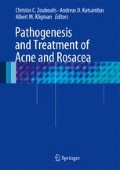Abstract
Although technological progress has created great benefits, at the same time a lot of industrial by-products and chemical wastes have been produced. Human health has been greatly affected by these environmental pollutants [1]. The skin is the largest organ in the human body and one of its main functions is to protect the body from noxious substances. Environmental pollutants are related to skin diseases such as contact dermatitis, chemical depigmentation, and chloracne [2]. Acne vulgaris is generally considered to be a disorder of adolescence, but environmental pollutants can result in an acneiform eruption called chloracne, a typical environmental skin disease, which is characterized by acne-like lesions, such as comedones (blackheads and whiteheads), cysts, and pustules, that occur following systemic absorption of chemical “chloracnegens.”
Access this chapter
Tax calculation will be finalised at checkout
Purchases are for personal use only
References
Pelclova D, Urban P, Preiss J, et al. Adverse health effects in humans exposed to 2,3,7,8- tetrachlorodibenzo -p-dioxin (TCDD). Environ Health. 2006;21(2):119–38.
English JS, Dawe RS, Ferguson J. Environmental effects and skin disease. Br Med Bull. 2003;68:129–42.
Bornemann W. Ueber die histologie der chloracne. Arch Dermatol Res. 1902;62:75–90.
Herxheimer K. Uber chloracne. Munch Med Wochenschr. 1899;46:278.
Tindall JP. Chloracne and chloracnegens. J Am Acad Dermatol. 1985;13:539–58.
Schwetz BA, Norris JM, Sparschu GL, et al. Toxicology of chlorinated dibenzo-p-dioxins. Environ Health Perspect. 1973;5:87–99.
Suskind RR. Chloracne, “the hallmark of dioxin intoxication”. Scand J Work Environ Health. 1985;11:165–71.
Link B, Gabrio T, Zoellner I, et al. Biomonitoring of persistent organochlorine pesticides, PCDD/PCDFs and dioxin-like PCBs in blood of children from South West Germany (Daded-Wuerttembergs) from 1993 to 2003. Chemosphere. 2005;58:1185–201.
Baccarelli A, Pesatori AC, Consonni D, et al. Health status and plasma dioxin levels in chloracne cases 20 years after the Seveso, Italy accident. Br J Dermatol. 2005;152(3):459–65.
Wolfe WH, Michalek JE, Miner JC, et al. Determinants of TCDD half-life in veterans of operation ranch hand. J Toxicol Environ Health. 1994;41:481–8.
Cheng WN, Coenraads PJ, Hao ZH, et al. A health survey of workers in the pentachlorophenol section of a chemical manufacturing plant. Am J Ind Med. 1993;24(1):81–92.
Piacitelli L, Marlow D, Fingerhut M, et al. A retrospective job exposure matrix for estimating exposure to 2,3,7, 8-tetrachlorodibenzo-p-dioxin. Am J Ind Med. 2000;38(1):28–39.
Guo YL, Yu ML, Hsu CC, Rogan WJ. Chloracne, goiter, arthritis, and anemia after polychlorinated biphenyl poisoning: 14-year follow-Up of the Taiwan Yucheng cohort. Environ Health Perspect. 1999;107(9):715–9.
Panteleyev AA, Roumak VS, Stepanova LV, Poznyakov SP, Bocharov BV. Clinical and ultrastructural characterization of human skin after exposure to dioxin-contaminated defoliants. In: Proceedings of Joint Russian–Vietnam Tropical Centre, Moscow; 1991. Pp. 300–4.
Chloracne ZC. Clinical manifestations and etiology. Dermatol Clin. 1990;8:209–13.
Jensen NE. Chloracne: three cases. Proc R Soc Med. 1972;65:687–8.
Geusau A, Jurecka W, Nahavandi H, et al. Punctate keratoderma-like lesions on the palms and soles in a patient with chloracne: a new clinical manifestation of dioxin intoxication? Br J Dermatol. 2000;143(5):1067–71.
Kerger BD, Leung HW, Scott P, et al. Age- and concentration-dependent elimination half-life of 2,3,7,8-tetrachlorodibenzo-p-dioxin in Seveso children. Environ Health Perspect. 2006;114(10):1596–602.
Hambrick GW. The effect of substituted naphthalenes on the pilosebaceous apparatus of rabbit and man. J Invest Dermatol. 1957;28:89–103.
Panteleyev AA,·Thiel T,·Rosenbach T et al (2000) Christiano acne chlorina and acne vulgaris – casual likeness or causal homology? Arch Dermatol Res 292(11):577–81.
Pastor MA, Carrasco L, Izquierdo MJ, et al. Chloracne: histopathologic findings in one case. J Cutan Pathol. 2002;29(4):193–9.
Panteleyev AA, Bickers DR. Dioxin-induced chloracne–reconstructing the cellular and molecular mechanisms of a classic environmental disease. Exp Dermatol. 2006;15(9):705–30.
McConnell EE, Moore JA. Toxicopathology characteristics of the halogenated aromatics. Ann N Y Acad Sci. 1979;320:138–50.
Loertscher JA, Sattler CA, Allen-Hoffmann BL. 2, 3,7,8- Tetrachlorodibenzo-p-dioxin alters the differentiation pattern of human keratinocytes in organotypic culture. Toxicol Appl Pharmacol. 2001;175(2):121–9.
Huelsken J, Vogel R, Erdmann B, et al. beta-Catenin controls hair follicle morphogenesis and stem cell differentiation in the skin. Cell. 2001;105(4):533–45.
Gawkrodger DJ. Chloracne: causation, diagnosis and treatment. J Dermatol Treat. 1991;2:73–6.
Geusau A, Tschachler E, Meixner M, et al. Olestra increases faecal excretion of 2,3,7,8-tetrachlorodibenzo-p-dioxin. Lancet. 1999;354(9186):1266–7.
Redgrave TG, Wallace P. Jandacek RJTso P。Treatment with a dietary fat substitute decreased Arochlor 1254 contamination in an obese diabetic male. J Nutr Biochem. 2005;16(6):383–4.
Author information
Authors and Affiliations
Corresponding author
Editor information
Editors and Affiliations
Rights and permissions
Copyright information
© 2014 Springer-Verlag Berlin Heidelberg
About this chapter
Cite this chapter
Ju, Q., Xia, L. (2014). Acne and Environmental Pollution (Chloracne). In: Zouboulis, C., Katsambas, A., Kligman, A. (eds) Pathogenesis and Treatment of Acne and Rosacea. Springer, Berlin, Heidelberg. https://doi.org/10.1007/978-3-540-69375-8_25
Download citation
DOI: https://doi.org/10.1007/978-3-540-69375-8_25
Publisher Name: Springer, Berlin, Heidelberg
Print ISBN: 978-3-540-69374-1
Online ISBN: 978-3-540-69375-8
eBook Packages: MedicineMedicine (R0)

